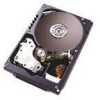IBM IC35L036UWDY10 Hard Drive Specifications - Page 228
Diagnostics, 17.1 Power on Diagnostics, 17.2 Self-test by SEND DIAGNOSTIC Command, self-test
 |
UPC - 000004119524
View all IBM IC35L036UWDY10 manuals
Add to My Manuals
Save this manual to your list of manuals |
Page 228 highlights
11.17 Diagnostics The drive will execute the bring-up operation at POR to assure the correct operation of the drive by validating components (ROM, RAM, Sector Buffer, EEPROM, HDC, Spindle Motor, Actuator), checking stored information in the reserved area and EEPROM, and verifying fault detects circuits. Self-test can be invoked by a SEND DIAGNOSTIC command. 11.17.1 Power on Diagnostics See Section 11.16.2 "Power On Reset" on page 210 for the description of the bring-up operation. 11.17.2 Self-test by SEND DIAGNOSTIC Command 11.17.2 .1 Default self-test The default self-test is invoked by the SlfTst bit in the SEND DIAGNOSTIC command. The response is simply a GOOD status if the test is successful or a CHECK CONDITION status if the test fails. 11.17.2 .2 Short and extended self-tests There are two other types of self-test that may be invoked using the Function Code field in the SEND DIAGNOSTIC command: a short self-test and an extended self-test. The tests performed in the short and extended self-tests are described in a later section. The time required by a logical unit to complete its extended self-test is reported in the Extended Self-test Routine Completion Time (Mode Page A). The results of self-test can be retrieved by a LOG SENSE command (Log Page 10). 11.17.2 .3 Self-test modes There are two modes for short and extended self-tests: a foreground mode and a background mode. These modes are described.below: Foreground mode When the drive receives a SEND DIAGNOSTIC command specifying a self-test to be performed in the foreground mode, the drive will return status for that command after the self-test has been completed. While performing a self-test in the foreground mode, the drive will respond to all commands except INQUIRY, REPORT LUNS, and REQUEST SENSE with a CHECK CONDITION status, a sense key of NOT READY and an additional sense code of LOGICAL UNIT NOT READY - SELF-TEST IN PROGRESS. If the drive is performing a self-test in the foreground mode and a test error occurs during the test, the drive will update the self-test results log page and report CHECK CONDITION status with a sense key of HARDWARE ERROR and an additional sense code of LOGICAL UNIT FAILED SELFTEST. The initiator may obtain additional information about the failure by reading the self-test results log page. An initiator may terminate a self-test that is being performed in the foreground mode using an ABORT TASK, ABORT TASK SET, or CLEAR TASK SET task management function. If the drive receives an ABORT TASK, ABORT TASK SET, or CLEAR TASK SET task management function while performing a self-test in the foreground mode, it will abort the self-test and update the self-test results log page. Background mode When the drive receives a SEND DIAGNOSTIC command specifying a self-test to be performed in the background mode, the drive will return status for that command as soon as the command descriptor block has been validated. After returning status for the SEND DIAGNOSTIC command specifying a self-test to be performed in the background mode, the drive will initialize the self-test results log page as follows. The Function Code from the SEND DIAGNOSTIC command will be placed in the Function Code field in the log page. The self-test Results field shall be set to 0Fh. After the self-test results log page is initialized, the Ultrastar 146Z10 hard disk drive specifications 212















